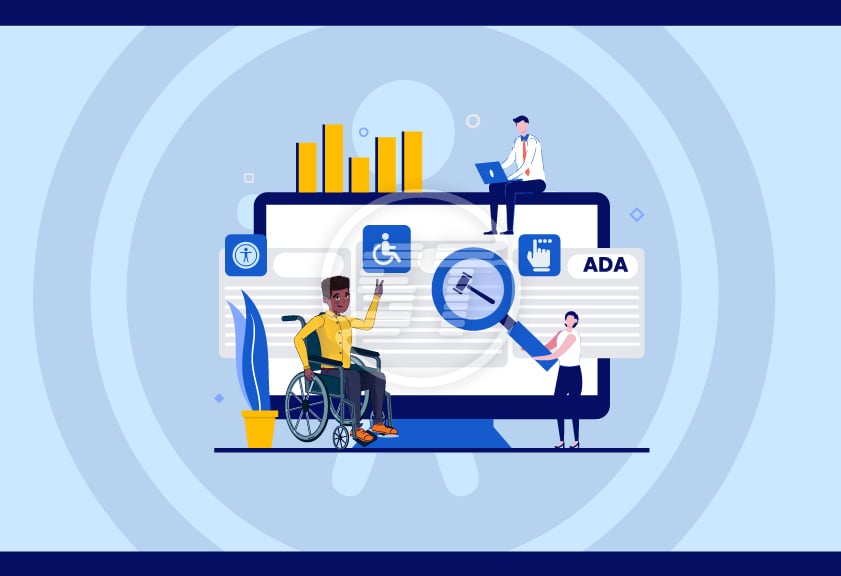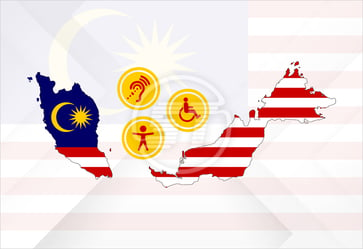A regular ADA compliance audit is crucial from a digital asset’s point of view to ensure its maximum accessibility. It is a critical process that ensures equitable access for individuals with disabilities to both physical spaces and digital platforms. With the growing emphasis on inclusivity, organizations must evaluate their environments to comply with the Americans with Disabilities Act (ADA) and related accessibility standards like WCAG 2.1. The audit serves multiple purposes, from enhancing usability and mitigating legal risks to improving overall user experience.
While automated website accessibility audit tools play a role in detecting accessibility issues, the importance of manual testing cannot be overstated. Manual testing provides contextual insights, real-world usability assessments, and addresses complex challenges that automated systems often overlook. It enables organizations to not only meet compliance standards but also deliver seamless interactions for users with disabilities.
Read along to learn more!
Steps to conduct an ADA compliance audit
Audit planning
- Establish objectives of the audit, such as ensuring ADA compliance, improving user accessibility, mitigating legal risks, or enhancing inclusivity.
- Determine the scope.
- Assemble the audit team.
- Develop an audit checklist.
- Risk assessment for the areas that could lead to non-compliance, such as outdated website designs or inaccessible entrances.
- Develop a realistic timeline with deadlines for each phase, including initial assessments, testing, reporting, and accessibility remediation.
Perform the website accessibility audit
As per the defined plan, begin the actual audit process, identify the accessibility barriers, and remove them.
Select testing tools and techniques
Choose software or online tools for initial scans of websites or applications (e.g. Axe, WAVE, Website Accessibility Checker, or Lighthouse). And plan for user testing with assistive technologies to identify usability issues automation may miss.
Documentation and reporting framework
Plan how findings will be documented, ensuring clarity and actionable recommendations. And include templates for reports, checklists, and remediation plans.
Expert tips for a successful WCAG accessibility compliance audit
Conducting a successful ADA compliance audit requires careful planning, expert execution, and attention to detail. So, what can be done to ensure an effective and comprehensive audit (according to experts)?
- Understand ADA requirements thoroughly
Familiarize with the applicable ADA Titles for example: Title I for employment, Title II for public entities, and Title III for public accommodations.
Refer to WCAG 2.1 guidelines for digital accessibility and the ADA standards for accessible design for physical spaces.
- Build a competent audit team
Include specialists like accessibility consultants, web developers, architects, and legal experts. Engage individuals with disabilities to provide first-hand insights during testing. (However, reaching out to a web accessibility partner is recommended to achieve accessibility goals within time and budget.)
- Use a comprehensive checklist
Develop a detailed checklist that covers all aspects of ADA compliance according to business requirements. Some complicated websites might need more effort than simple ones. Also, accessibility implementation varies as per industry, products, and types of services.
- Prioritize high impact areas
Focus on areas with the highest public interaction or where accessibility barriers could have the most significant consequences.
Address issues affecting critical services or high-traffic digital pages first.
- Include end-user feedback
Gather insights from users with disabilities about their experiences with the facilities or digital platforms.
Conduct usability testing sessions to uncover barriers.
- Educate the team
Offer ADA training for all stakeholders to make them understand the importance of accessibility. Ensure ongoing education to maintain awareness and compliance.
- Conduct regular accessibility audit
Treat ADA compliance as an ongoing process, not a one-time effort. Schedule periodic audits to ensure sustained compliance and address new issues as they arise.
- Engage legal experts
Consult ADA legal specialists to interpret regulations and confirm compliance. Ensure that policies and practices align with legal requirements. Although if an organization has partnered with accessibility audit organizations/agencies, they might help with legal consultation as well.
- Leverage tax incentives
Explore ADA tax credits (e.g., IRS Section 44) available for organizations making accessibility improvements.
Common challenges in ADA compliance accessibility audit
An ADA web accessibility audit can uncover significant barriers for users with disabilities, but conducting the audit effectively comes with its own challenges. There are several challenges encountered while ADA audit execution such as adhering to complex accessibility regulations, ensuring compatibility with variety of assistive technologies, and inconsistent testing across different devices, browsers and operating systems.
Some of the other crucial challenges are:
- Choosing the right testing method - manual or automated
Challenge: Automated tools identify only 20-50% of accessibility issues but relying solely on manual testing can be resource intensive.
Solution: Combine both methods. Use automated tools for initial scans and manual testing to address critical issues.
- Balancing compliance with aesthetic and branding goals
Challenge: Brand colors, custom fonts, unique typography, or font sizes may not meet WCAG criteria. Videos, animations, and interactive content used for branding may lack captions, audio descriptions, or keyboard functionality. And custom elements like branded icons, logos, or unique design patterns may not be screen reader friendly or easily navigable.
Solution: Adjust shades of brand colors and use accessible colors.
Choose legible fonts with sufficient spacing.
Provide synchronized captions, transcripts, and audio descriptions for videos. Also, interactive elements must be keyboard accessible.
Use CSS and ARIA attributes to make decorative elements non-intrusive to assistive technologies.
- Identifying dynamic content issues
Challenge: Modern websites often use dynamic elements like pop-ups, sliders, and interactive forms, which may not be accessible to assistive technologies.
Solution: Test dynamic content for focus management, ARIA roles, and proper keyboard navigation.
- Accessibility of third-party content
Challenge: Embedded third-party tools may not meet accessibility standards.
Solution: Choose third-party providers committed to accessibility and evaluate their tools during the audit.
- Ensuring keyboard navigation
Challenge: Many websites fail to ensure that all functionality is operable using only a keyboard, affecting users with motor disabilities.
Solution: Conduct thorough testing to ensure logical tab orders, visible focus indicators, and no keyboard traps.
- Handling legacy systems
Challenge: Older websites or systems may have significant accessibility gaps due to outdated coding practices.
Solution: Develop a phased remediation plan to prioritize critical updates while gradually improving overall accessibility.
- Misalignment between design and development
Challenge: Design teams may create visually appealing elements that are not accessible, leading to conflicts during development.
Solution: Integrate accessibility into the design phase and conduct accessibility reviews at every stage of development.
Benefits of an ADA compliance audit
- Enhances accessibility for all users
Identifies and removes barriers that prevent individuals with disabilities from accessing facilities, websites, and services.
Improves usability, benefiting not only people with disabilities but also those using mobile devices, older individuals, or people with temporary impairments.
- Mitigates legal risks
Ensures compliance with the Americans with Disabilities Act (ADA), reducing the likelihood of lawsuits, fines, and penalties.
Demonstrates due diligence in meeting accessibility standards, such as WCAG 2.1, which can serve as legal protection.
- Expands market reach
Increases accessibility to a broader audience, including 61 million (approx.) adults in the U.S. with disabilities.
Enhances customer satisfaction and loyalty by creating an inclusive environment for all users.
- Improves brand reputation
Positions the organization as socially responsible and committed to inclusivity.
Builds trust with customers, employees, and stakeholders, strengthening the brand’s public image.
- Boosts search engine optimization (SEO)
Adhering to accessibility standards improves search engine rankings.
Creates well-structured content that benefits users and search engines alike.
- Provides competitive advantage
Differentiates the organization from competitors that may not prioritize accessibility.
Attracts new customers and clients by showcasing inclusivity as a core value.
- Promotes innovation and efficiency
Encourages organizations to adopt best practices in design and technology.
Streamlines content creation and development workflows by integrating accessibility from the start.
- Facilitates long-term accessibility compliance
Provides a roadmap for ongoing accessibility improvements, making it easier to maintain compliance as standards evolve.
Helps future-proof digital assets against changes in regulations or technology.
In a nutshell,
An ADA compliance audit is not just a legal obligation but a vital step toward creating an inclusive, accessible, and user-friendly environment for everyone. The benefits of WCAG website accessibility audit are extending far beyond compliance, offering opportunities for innovation, market expansion, and strengthening brand reputation.
Incorporating accessibility into business operations demonstrates a commitment to equality and ensures that the organization is an inclusive world. By prioritizing ADA compliance, businesses contribute to a society where everyone can engage with the services and thrive.
So, take proactive steps and reach out to an experienced ADA compliance audit partner to plan and execute ADA compliance audit.
Looking for a quick way to check your website’s accessibility? Try Skynet Technologies’ Accessibility Checker to identify WCAG and ADA compliance issues and improve digital inclusivity
If you're looking to improve your website meets ADA compliance standards, a manual accessibility audit is the most thorough approach. Our expert team can provide detailed, hands-on assessments that go beyond automated tools, identifying issues that could impact users with disabilities. With our comprehensive WCAG audit report samples, you'll get clear insights and actionable steps to address any gaps in accessibility. Ready to enhance your website's inclusivity? Reach out [email protected] for a tailored manual ADA compliance audit and a roadmap to managed website accessibility compliance!


